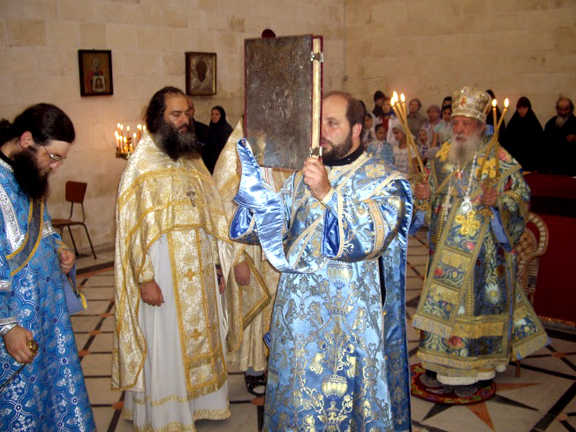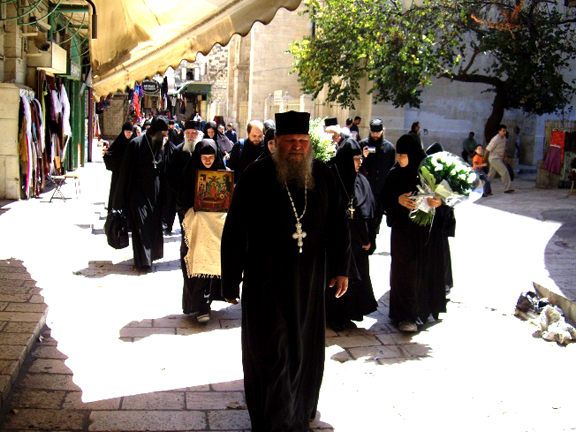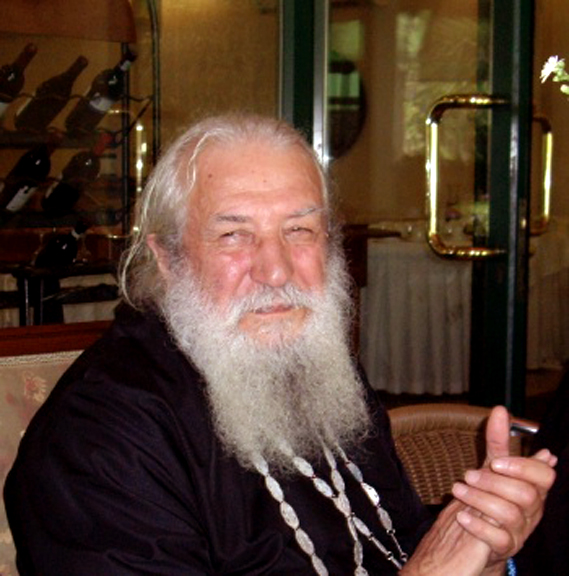
RUSSIAN ECCLESIASTICAL MISSION IN JERUSALEM: August 31, 2006
On His namesday, Metropolitan Laurus Celebrates Divine Liturgy at the "Russian Excavations" As the Gospel tells us, Golgotha and, "nigh at hand," the Sepulcher, which was cut out of a cliff side in the garden of Joseph of Arimathea, were "near to the city," that is, outside of it; as Apostle Paul also says: "Jesus… suffered without the gate" (Hebrews 13:12).
The wall which today separates the old city on the west from the Jewish part (between the Damascus Gates and the Citadel) did not exist during the days of the Savior. The city wall at the time was located further east, though not far from here, and had a gate on this side called "Judgment Gate," that is, at this gate the Romans pronounced the final sentence to those condemned to death. This wall was built in the 8 th century BC by the Hebrew King Ezekiel to prevent the assault of the Assyrians, and was rebuilt two centuries later after the city was razed. It remained until the days of Christ, and the Lord Savior, on His way to Golgotha with the Cross on His shoulders, doubtless passed through the Judgment Gates as He exited the city.
The ancient wall and the Judgment Gates were accidentally discovered in the 19 th century when the Russian Government purchased a parcel of land from the Abyssinians near the Holy Sepulcher of Christ. This parcel was meant to for the construction of a Russian consulate, but as the plot was cleared, an architect discovered the remains of a massive wall, the stones of which bore the characteristic chisel-work of a certain age. Construction was halted; excavations then began under the guidance of the Chief of the Russian Ecclesiastical Mission in Jerusalem at the time, Archimandrite Antonin (Kapoustin). Through scholarly study it was determined that this wall was the external city wall during the life of Jesus Christ. It survived at a height of 2 to 2 ? meters. Between two pilasters lies a worn threshold, gleaming from wear, with clear signs of hinge holes for the gates. On both sides are uneven flagstones for a carriageway. Since these gates are the closest ones to Golgotha, there is no doubt that these are the Judgment Gates of old, and that the Divine Cross-bearer passed over this threshold.
Other archaeological treasures were also discovered on the property. An entire archway resting on two columns was unearthed, dating to the ancient architecture of various eras. This discovery revealed that the basilica of the Sepulcher of Christ built by Constantine the Great once extended this far, and that this archway is part of a gallery that once surrounded this grand temple!
These discoveries were acknowledged by scholars throughout the world. The Russian consulate chose another site for its headquarters, and over this holy site—the last stage of the Way of the Cross—a temple was built, elevated somewhat over the holy threshold, on a wide plaza discovered at the same time, apparently also from St Constantine's basilica. In the middle of this area, a stone altar table was found, probably from a side chapel of the basilica, which, it is known, encompassed a whole series of holy sites under one roof. This altar table was left in the middle, and an altar and iconostasis were erected to the east, and the church dedicated to St Alexander Nevsky. The holy threshold was included in this edifice, nearby which several rooms for pilgrims were built. The threshold was covered with a wooden frame under glass. Behind it is a large crucifix affixed to a piece of local stone. An ancient wall extends on the left, meeting the new wall, where a large icon depicting the Savior bearing the Cross hangs. These grandiose remains of the wall continue past the Russian property into the Abyssinian monastery next door.
This holy threshold is visited by the Russian clergy on the evening of Holy Thursday. They descend from St Mary Magdalene Church in Gethsemane, after matins and the reading of the Twelve Gospels, carrying candles and singing, joined by the Russian population of the Holy City. There, the Passion service is held on the day when the Church commemorates the salvific sufferings of Her Chief, on the very spot where He ascended to Golgotha under the weight of the Cross. The church at the "Excavations" is the property of the Orthodox Palestine Society and is under the spiritual care of the clergy of the Russian Ecclesiastical Mission in Jerusalem of the Russian Orthodox Church Outside of Russia.
 On August 30, his namesday, His Eminence Metropolitan Laurus celebrated Divine Liturgy here along with Hegumen Andronik (Kotliaroff); Priest Serafim Gan; Hieromonk Nicholas (Perekrestov); Hieromonk Savva; Deacon Nicholas Olhovsky and Hierodeacon Cyprian (Alexandrou). Praying at Liturgy were Archimandrite Elisei; Hegumen Tikhon; Protopriest Roman Radvan, a representative of the Jerusalem Patriarchate; Protodeacon Victor Lochmatov; Abbess Moisseia and Abbess Elizabeth of the Jerusalem convents of the Russian Orthodox Church Outside of Russia. On August 30, his namesday, His Eminence Metropolitan Laurus celebrated Divine Liturgy here along with Hegumen Andronik (Kotliaroff); Priest Serafim Gan; Hieromonk Nicholas (Perekrestov); Hieromonk Savva; Deacon Nicholas Olhovsky and Hierodeacon Cyprian (Alexandrou). Praying at Liturgy were Archimandrite Elisei; Hegumen Tikhon; Protopriest Roman Radvan, a representative of the Jerusalem Patriarchate; Protodeacon Victor Lochmatov; Abbess Moisseia and Abbess Elizabeth of the Jerusalem convents of the Russian Orthodox Church Outside of Russia. The Gethsemane choir sang beautifully under the direction of Nun Ambrosia. At the end of the service, Hegumen Andronik congratulated His Eminence on his namesday. In his response, His Eminence Vladyka expressed gratitude to everyone for their holy prayers and his profound joy at the services conducted here at the threshold of Judgment Gates. After the veneration of the cross, the clergy and worshipers, headed by the First Hierarch, headed for the Church of the Resurrection of Christ, where they venerated the Life-bearing Sepulcher of the Lord, Golgotha and other holy items. The Gethsemane choir sang beautifully under the direction of Nun Ambrosia. At the end of the service, Hegumen Andronik congratulated His Eminence on his namesday. In his response, His Eminence Vladyka expressed gratitude to everyone for their holy prayers and his profound joy at the services conducted here at the threshold of Judgment Gates. After the veneration of the cross, the clergy and worshipers, headed by the First Hierarch, headed for the Church of the Resurrection of Christ, where they venerated the Life-bearing Sepulcher of the Lord, Golgotha and other holy items.
 A trapeza organized by Abbess Elizabeth, Nun Katherine and the sisters of Gethsemane was offered at Hotel Christmas, where the Head of the part of the Russian Orthodox Church abroad was congratulated by Fr Elisei; Fr Serafim; Fr Nicholas; Fr Savva; Fr Roman (who at one times studied in Holy Trinity Monastery) and many others. In conclusion, His Eminence Vladyka thanked everyone for their kind attention, prayers and gifts, and asked for their prayers for the safe return to New York of the delegation, where a regular session of the Synod of Bishops is scheduled for next week. A trapeza organized by Abbess Elizabeth, Nun Katherine and the sisters of Gethsemane was offered at Hotel Christmas, where the Head of the part of the Russian Orthodox Church abroad was congratulated by Fr Elisei; Fr Serafim; Fr Nicholas; Fr Savva; Fr Roman (who at one times studied in Holy Trinity Monastery) and many others. In conclusion, His Eminence Vladyka thanked everyone for their kind attention, prayers and gifts, and asked for their prayers for the safe return to New York of the delegation, where a regular session of the Synod of Bishops is scheduled for next week.
We wish His Eminence Metropolitan Laurus good health and many Divine mercies!
|